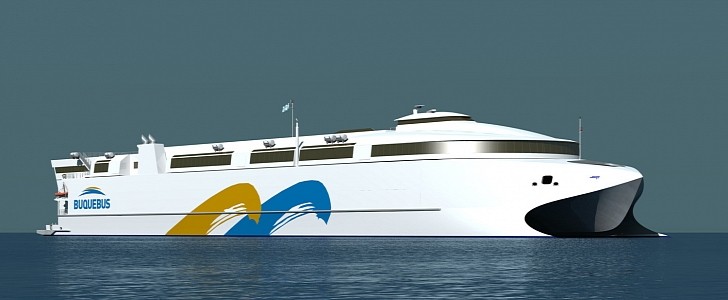A renowned shipyard and a top expert in maritime power solutions have joined forces to put together an innovative vessel that could become not only the largest aluminum catamaran in the world but also one of the greenest by incorporating a dual-fuel system.
Wartsila is known for its high-performance waterjets, engines, propulsion control systems, and other solutions for maritime operations. The Wartsila 31DF duel fuel engine is considered the most powerful in its class, with an output of up to 9.6 MW at 750 rpm.
The diesel version of the Warstila 31 was recognized as the world’s most efficient 4-stroke diesel engine by the Guinness World Records, and this dual-fuel version is on the same path to success, promising unmatched performance and fuel efficiency.
Two of the Wartsila 31DF engines will be powering a new, high-speed catamaran ferry that’s currently under construction at the Incat shipyard in Tasmania, Australia. In addition to the engines, Wartsila will also provide its next-generation WXJ axial flow waterjets, propulsion control systems, plus its solution for LNG (liquefied natural gas) storage.
The LNG fuel for this future ferry will come from the company that will operate it. Buquebus is an Argentinian ferry operator that also has its own LNG production facility in San Vicente, Argentina.
This new ferry is not the first step towards greener operations for the Argentinian operator. A few years ago, HSC Francisco became the first dual-fuel ship in Latin America, with the capacity to transport 1,000 passengers and 150 cars at a high speed of 58 knots (66.7 mph/107 kph).
The ferry that’s currently being built will take things even further, with an almost double capacity. At a length of 130 meters (426 feet) and a width of 32 meters (105 feet), it will be able to carry 2,100 passengers and 226 cars.
By running on LNG, this high-speed large catamaran will also be able to operate in emission control areas (ECAs). But on a regular basis, it will cruise between Argentina and Uruguay, at over 40 knots (46 mph/74 kph).
The diesel version of the Warstila 31 was recognized as the world’s most efficient 4-stroke diesel engine by the Guinness World Records, and this dual-fuel version is on the same path to success, promising unmatched performance and fuel efficiency.
Two of the Wartsila 31DF engines will be powering a new, high-speed catamaran ferry that’s currently under construction at the Incat shipyard in Tasmania, Australia. In addition to the engines, Wartsila will also provide its next-generation WXJ axial flow waterjets, propulsion control systems, plus its solution for LNG (liquefied natural gas) storage.
The LNG fuel for this future ferry will come from the company that will operate it. Buquebus is an Argentinian ferry operator that also has its own LNG production facility in San Vicente, Argentina.
This new ferry is not the first step towards greener operations for the Argentinian operator. A few years ago, HSC Francisco became the first dual-fuel ship in Latin America, with the capacity to transport 1,000 passengers and 150 cars at a high speed of 58 knots (66.7 mph/107 kph).
The ferry that’s currently being built will take things even further, with an almost double capacity. At a length of 130 meters (426 feet) and a width of 32 meters (105 feet), it will be able to carry 2,100 passengers and 226 cars.
By running on LNG, this high-speed large catamaran will also be able to operate in emission control areas (ECAs). But on a regular basis, it will cruise between Argentina and Uruguay, at over 40 knots (46 mph/74 kph).







